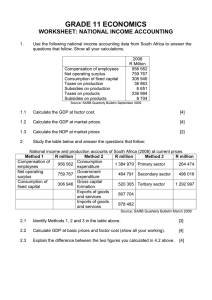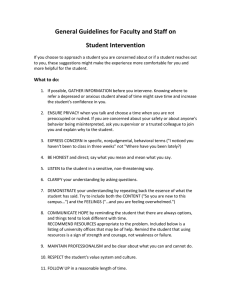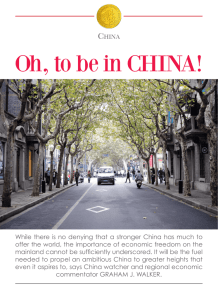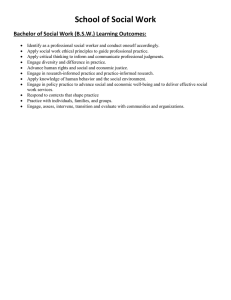Policy and Health in Asia Financing and Allocating Public Expenditures R Research Brief
advertisement
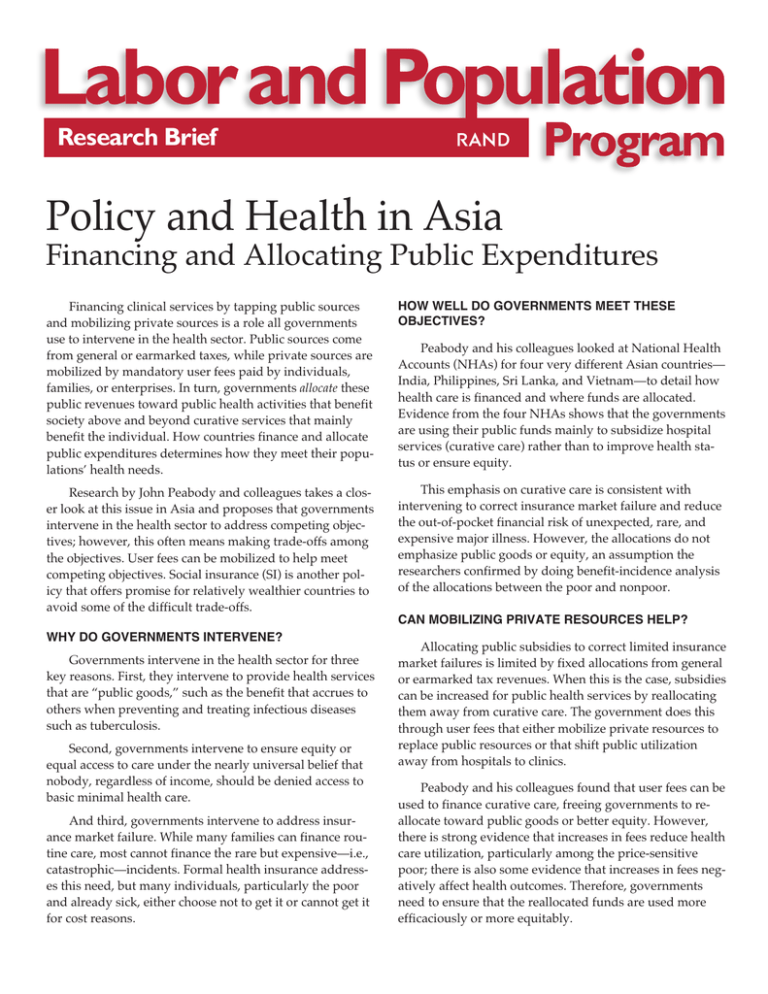
Research Brief R Policy and Health in Asia Financing and Allocating Public Expenditures Financing clinical services by tapping public sources and mobilizing private sources is a role all governments use to intervene in the health sector. Public sources come from general or earmarked taxes, while private sources are mobilized by mandatory user fees paid by individuals, families, or enterprises. In turn, governments allocate these public revenues toward public health activities that benefit society above and beyond curative services that mainly benefit the individual. How countries finance and allocate public expenditures determines how they meet their populations’ health needs. HOW WELL DO GOVERNMENTS MEET THESE OBJECTIVES? Research by John Peabody and colleagues takes a closer look at this issue in Asia and proposes that governments intervene in the health sector to address competing objectives; however, this often means making trade-offs among the objectives. User fees can be mobilized to help meet competing objectives. Social insurance (SI) is another policy that offers promise for relatively wealthier countries to avoid some of the difficult trade-offs. This emphasis on curative care is consistent with intervening to correct insurance market failure and reduce the out-of-pocket financial risk of unexpected, rare, and expensive major illness. However, the allocations do not emphasize public goods or equity, an assumption the researchers confirmed by doing benefit-incidence analysis of the allocations between the poor and nonpoor. Peabody and his colleagues looked at National Health Accounts (NHAs) for four very different Asian countries— India, Philippines, Sri Lanka, and Vietnam—to detail how health care is financed and where funds are allocated. Evidence from the four NHAs shows that the governments are using their public funds mainly to subsidize hospital services (curative care) rather than to improve health status or ensure equity. CAN MOBILIZING PRIVATE RESOURCES HELP? WHY DO GOVERNMENTS INTERVENE? Governments intervene in the health sector for three key reasons. First, they intervene to provide health services that are “public goods,” such as the benefit that accrues to others when preventing and treating infectious diseases such as tuberculosis. Second, governments intervene to ensure equity or equal access to care under the nearly universal belief that nobody, regardless of income, should be denied access to basic minimal health care. And third, governments intervene to address insurance market failure. While many families can finance routine care, most cannot finance the rare but expensive—i.e., catastrophic—incidents. Formal health insurance addresses this need, but many individuals, particularly the poor and already sick, either choose not to get it or cannot get it for cost reasons. Allocating public subsidies to correct limited insurance market failures is limited by fixed allocations from general or earmarked tax revenues. When this is the case, subsidies can be increased for public health services by reallocating them away from curative care. The government does this through user fees that either mobilize private resources to replace public resources or that shift public utilization away from hospitals to clinics. Peabody and his colleagues found that user fees can be used to finance curative care, freeing governments to reallocate toward public goods or better equity. However, there is strong evidence that increases in fees reduce health care utilization, particularly among the price-sensitive poor; there is also some evidence that increases in fees negatively affect health outcomes. Therefore, governments need to ensure that the reallocated funds are used more efficaciously or more equitably. implemented SI (italicized in red in the figure and shown here as they were when they implemented it), there is an order-of-magnitude difference between the two sets in terms of GDP per capita, GDP growth, and percent of urbanization (shown in parentheses). 10,000 Real GDP per capita, 1992 $ The researchers provide evidence that supports the notion that individuals are willing to pay at least a share of the cost of improvements in access and quality, especially for drugs. However, the wealthy are willing to pay a lot more than the poor. Therefore, if governments charge the “average willingness to pay” fees to finance quality improvements, they should expect that utilization by the wealthy will increase but utilization by the poor will fall. WHAT IS THE PROMISE OF SOCIAL INSURANCE? Social insurance (SI) can help address two consequences associated with mobilizing resources through user fees. First, SI provides insurance coverage because individuals are prepaying their medical care expenditures into a fund. Second, SI can address the problem of equal access to medical care and the associated health consequences by subsidizing the enrollment of the poor into SI. This also reduces direct subsidies to facilities. Facilities can recoup lost revenues by providing care for the poor, who become insured patients. In this way, SI ensures that public subsidies are better targeted to the poor and that the facilities that get the indirect subsidies are the ones that care for the poor. While SI holds promise, it creates problems that, if not addressed as part of insurance design, could outweigh its benefit. The most obvious is that SI must be compulsory to be financially viable, enrolling at least substantial segments of the population, such as the wage sector. Other problems include how SI is financed, what effect it has on private providers, and whether it increases utilization of health care and/or encourages faster-than-optimal adoption of technology, which, in turn, can lead to rapid medical cost inflation. However, assuming these problems can be addressed, the policy question is: When is SI feasible in low- and middle-income countries? Peabody and his colleagues find that while many high-performing Asian countries have implemented SI, they did so only when they had relatively high income levels (US$3,000 per capita), were largely urbanized, and had large formal wage sectors relative to informal sectors. The figure in the next column shows that when we compare those countries implementing or considering implementing SI with those that have already Taipei, China (57%) Japan 9,000 Singapore (100%) 8,000 7,000 6,000 Korea (66%) 5,000 4,000 3,000 Malaysia (44%) Philippines (44%) 2,000 India (26%) 1,000 Thailand (35%) Sri Lanka (22%) Indonesia (32%) China (28%) 0 0 Bangladesh (17%) 2 4 6 8 10 12 Pakistan (33%) Real annual GDP growth, 1960–1992 (%) GDP and percent urban are for year when universal insurance instituted; percent urban is in parentheses. IMPLICATIONS FOR POLICYMAKERS In light of these findings, policymakers might be advised to use their public subsidies to improve health status by following several general pricing policies: Pricing policies should be used (1) to allocate higher subsidies for services that are more efficiently provided by the public sector, (2) where demand is “price-elastic” (i.e., sensitive to changes in pricing), and (3) for services for which there is limited availability in the private sector. Also, policymakers must deal with the potential downside of user fees by conducting well-designed longitudinal studies with control groups and by ensuring that all userfee interventions and pricing strategies are pilot-tested before being implemented nationally. Finally, because implementing SI policies requires that conditions be right in developing countries and that appropriate capabilities be in place, policymakers should take a deliberate approach, developing the necessary infrastructure for successful implementation while waiting for such conditions to develop. The preparation of this brief was supported by the RAND Center for the Study of the Family in Economic Development, which is supported in part by a program project from the National Institute for Child Health and Human Development. The research summarized in this Research Brief was carried out within RAND’s Labor & Population Program. Results are described in detail in John W. Peabody et al., Policy and Health: Implications for Development in Asia, Cambridge University Press, 1999, 441 pp. $44.95 (hardcover), ISBN: 0-521-66164-1. To order, call 1-800-872-7423 or 212-924-3900. R 1700 Main Street, P.O. Box 2138, Santa Monica, California 90407-2138 • Telephone 310-393-0411 • FAX 310-393-4818 1200 South Hayes Street, Arlington, Virginia 22202-5050 • Telephone 703-413-1100 • FAX 703-413-8111 201 North Craig Street, Suite 202, Pittsburgh, Pennsylvania 15213-1516 • Telephone 412-683-2300 • FAX 412-683-2800 Newtonweg 1, 2333 CP Leiden, The Netherlands • Telephone 011-31-71-524-5151 • FAX 011-31-71-524-5191 RB-5069 (2003)
